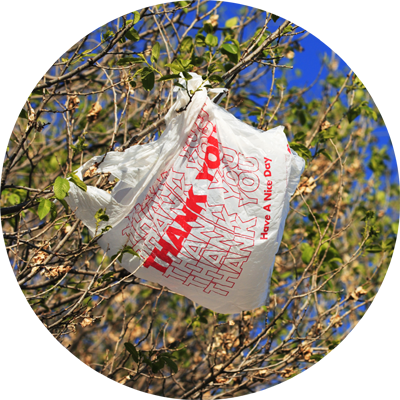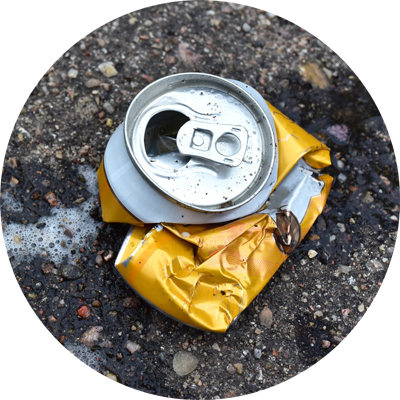Water Environment Services
Executive Sessions: BCC, WES and NCPRD - Feb. 28 2023
Policy Session: Intergovernmental Agreement between Water Environment Services and the City of Milwaukie for the Kellogg Good Neighbor Program - Feb. 15, 2023
Executive Sessions: BCC, WES and NCPRD - Feb. 14, 2023
If it’s on the ground, it’s in our water
When trash — plastic bags, bottles, cigarette butts, etc. — is thrown on the ground, it gets washed into storm drains and directly into our waterways. In addition to potentially choking, suffocating, or disabling aquatic life like ducks, fish, turtles, and birds, litter decreases oxygen levels in the water when it decays. Litter is one of the most unsightly forms of pollution in our local waterways and can easily be prevented. Most litter can be recycled, which protects the environment and saves our natural resources.
The lifespan (decomposition time) of some commonly littered items

Cigarette butts: 1–5 years
Myth: Cigarette filters are biodegradable.
Fact: The acetate filters can take many years to decompose. Also, the toxic chemicals the filter was designed to trap leak out into aquatic ecosystems, threatening marine life. Cigarette butts may seem small, but with millions of butts littered every year, they are one of the biggest sources of pollution.

Plastic bags: 10–20 years
When larger pieces of plastic waste are disposed of in the environment, they get weathered and degrade. These larger pieces of plastic break down into smaller and smaller pieces and are eventually reduced to microplastic particles. Microplastics are eaten by fish, birds, and any animals drinking the water.

Aluminum cans: 200–500 years

Glass bottles: 1 million years
How can you help keep our waters clean?
- Carry a bag for waste along in the car to eliminate the temptation to throw it out the window. Put litter in your pocket until you find a recycling container or trash can.
- Recycle and reuse items whenever possible. Glass, paper, metal, cardboard, and some plastics can be recycled.
- Pick up one piece of litter every day! That's 365 fewer pieces of litter on our streets, in our parks, and around our schools, thanks to you. Imagine if everyone picked up just one piece!
- Make sure your trash bins have lids that can be securely attached. Do not put out open containers or boxes filled with debris.
- Keep litter out of pick-up truck beds and cover loads, so items are not blown off to the ground.
- Join a clean-up event.
Clackamas Water Environment Services now accepting grant proposals of up to $30,000 for watershed improvement
Clackamas Area Interceptor Improvement Project
Clackamas Water Environment Services (WES) owns and operates the sewer infrastructure transporting wastewater from homes and businesses in Happy Valley, and the unincorporated areas around it, to our water resource recovery facilities. The existing Clackamas Area primary sewer line (interceptor) has served unincorporated Clackamas County, Happy Valley and Carver well. However, improvements and upsizing are needed for WES to continue to provide a resilient, reliable sanitary sewer system to serve our community in the future.
The Clackamas Area Interceptor Improvement Project will replace existing pipes with larger, more resilient pipes to increase capacity. In some cases, the pipes may be relocated to improve the overall connections of the system. The project is expected to take four years to complete design, permitting and easement acquisition. Construction will occur in a phased approach, likely beginning in 2026.
The Clackamas Area Interceptor Improvement Project Virtual Meeting - Learn more about the project and meet the team!
Locations
The Clackamas Area Interceptor Improvement Project includes five miles of pipes divided into four segments for construction purposes.
Project Planning
 One of the first tasks is to create a baseline of conditions along the pipeline route. Field crews will be surveying land, locating utilities, identifying potential environmental, cultural, and historic resources to protect, and assessing the topography, soil, and geology. The interceptor work will be mainly within the public right-of-way. Property owners will be contacted before access is needed on private property.
One of the first tasks is to create a baseline of conditions along the pipeline route. Field crews will be surveying land, locating utilities, identifying potential environmental, cultural, and historic resources to protect, and assessing the topography, soil, and geology. The interceptor work will be mainly within the public right-of-way. Property owners will be contacted before access is needed on private property.
The majority of the Project is within a busy commercial and industrial area. Maintaining access to private property is essential. We will coordinate with local businesses, Oregon Department of Transportation (ODOT), the railroad, and other agencies and service providers in the area.
This Project includes sensitive environmental areas, including Rock Creek, wetlands, and stream crossings. The Clackamas Area Interceptor Project will seek to minimize potential impacts to fish and wildlife habitats during design and construction.
Community members, the WES Advisory Committee, industry experts, and elected officials provided vital input to prioritize this Project as part of the Capital Improvement Master Plan.
 Translate
Translate






